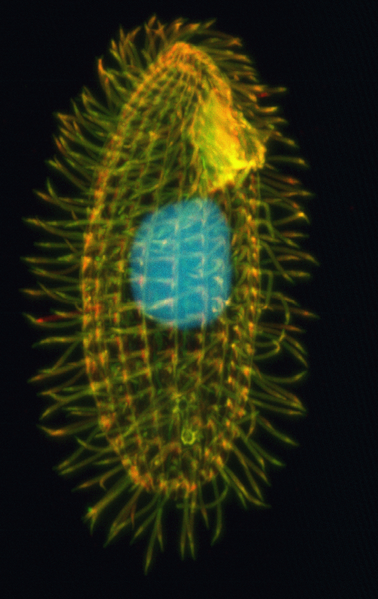Meet Tetrahymena thermophila, a one-celled eukaryote with seven different sexes
(aka mating types). A cell of one mating type can successfully mate with a cell
from any of the other six mating types. And that’s not even the most interesting part of
this tiny creature’s sex life. It turns out that the mating types are assigned stochastically. According to first author
Marcella Cervantes of the University of California, Santa Barbara and her
colleagues, each cell’s mating type is effectively determined by random chance rather than by genetic history.
Our story begins with the observation
that T. thermophila have two nuclei
rather than one. One nucleus contains the ‘somatic’ genome, which is
responsible for the everyday running of the cell. The other, smaller nucleus
contains the inactive ‘germline’ genome. We keep our germline genomes in our
ovaries and testes. Within the germline genome are all seven pairs of sex
determination genes, one for each of the possible mating types. The somatic
genome contains only a single set of mating type genes, and it is this set that
determines what that cell’s sex will be.
This means that while each T.
thermophila cell contains all the genetic
material necessary to become any mating type, six of those genes are only found
in the quiescent germline genome. Only one set of mating type genes finds its
way into the actively expressed somatic genome. Here’s how that happens.
When two T. thermophila mate, they exchange genetic material with each other
(unlike with our unions, no third individual is created). Both cells
subsequently destroy their own somatic genomes. They then use material from
their germline genomes to construct new somatic genomes. But remember, the
germline genome includes genes for all seven sexes. During the process of
rebuilding the somatic genome, six of those mating types genes are excised so
that only a single one remains. There is an equal probability that any one of
the seven sets of mating type genes could be the last one standing.
This means that the sex of the cell
after a conjugation event is in no way related to the sex of that same cell
before that event. Meanwhile, the ‘reborn’ cell retains all the mating type
genes within its own germline genome so that it can continue the tradition.
You might be wondering why an
organism would need seven different sexes. Note that T. thermophila only mate under conditions of extreme duress. When you're in danger of starving to death, it’s best not to waste too much time looking for a suitable mate,
especially when you’re only 40 or so microns long and can only travel so far.
If you can successfully mate with six out of every seven potential partners you meet, so much
the better.
Credit: Robinson, R. (2006). Ciliate Genome Sequence Reveals Unique Features of a Model Eukaryote PLoS Biology, 4 (9) DOI: 10.1371/journal.pbio.0040304
Article: Cervantes, M., Hamilton, E., Xiong, J., Lawson, M., Yuan, D., Hadjithomas, M., Miao, W., & Orias, E. (2013). Selecting One of Several Mating Types through Gene Segment Joining and Deletion in Tetrahymena thermophila PLoS Biology, 11 (3) DOI: 10.1371/journal.pbio.1001518.

No comments:
Post a Comment